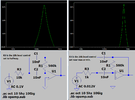Super-Dave
Member
In considering component values for an audio spectrum analyzer bandpass filters (4th order Sallen Key Butterworth) using a TL074 opamps, is there a specific range of values I should adhere to? Is there too high or too low of a value I should stay away from? I don't want weird oscillations, clipping or distortions.
Again, same question regarding the gain. Would it be a mistake to use too low a value (single or double digit ohms) or too high a value (910k-1m) that would overheat, wipe out the op-amp, or result in sub-par performance?
Finally, I know not to use electrolytic caps for bandwidth filtering. I have 2 assortments of poly film caps & ceramic caps. When should I choose one over the other, and why? I have read somewhere that ceramic caps can act as a microphone and introduce unintended input, but when, where, how & why? If I do use them, are there values I should stay away from?
I can't find any info online about this stuff (or I'm asking google the wrong questions). I'm hoping SOMEONE here knows more about this than I do and is willing to share that knowledge.
Again, same question regarding the gain. Would it be a mistake to use too low a value (single or double digit ohms) or too high a value (910k-1m) that would overheat, wipe out the op-amp, or result in sub-par performance?
Finally, I know not to use electrolytic caps for bandwidth filtering. I have 2 assortments of poly film caps & ceramic caps. When should I choose one over the other, and why? I have read somewhere that ceramic caps can act as a microphone and introduce unintended input, but when, where, how & why? If I do use them, are there values I should stay away from?
I can't find any info online about this stuff (or I'm asking google the wrong questions). I'm hoping SOMEONE here knows more about this than I do and is willing to share that knowledge.


